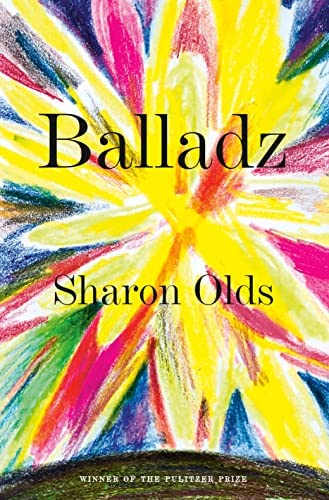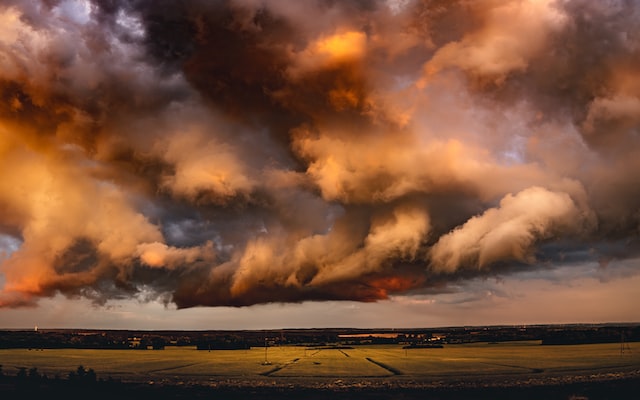by Stan Galloway

Following her genre-named collections Odes (2016) and Arias (2019), Sharon Olds brings us Balladz (yes, with a bad-ass zee; Knopf, 2022). These are not strum-along-with-your-guitar type ballads, though. Nor are they predominantly traditional Emily Dickinson-style alternating tetrameter/trimeter hymn stanzas (more on this later). These are poems in the style and theme that Olds has pioneered and perfected for a lifetime.
The book is divided into five sections, numbered and named.
The first section chronicles COVID-19 quarantine management in Olds’s eclectic fashion. The opening poem, “Quarantine Morning,” opens with the question, “how much difference is there, anymore / between me and a cadaver?” From there the poem begs the age-old question: Is there sex after death? And from there, it explores the intersection of sex and death in her own family history, concluding with the realization that death has become a metaphor for her own divorce. This is the pattern of Olds’s poetry: begin with a thought or image and weave associations through it that ultimately arrive at tapestry.
The first section contains 27 poems, continuing the motifs of family, death, sex, and coping. The final poem of this first section, “A Song Near the End of the World,” describes a bear seen passing outside the speaker’s window. The bear enters the collection earlier, in “After,” and is remembered at this point. The poem is an elegy of sorts (one of many; the fifth section is titled Elegies) for Galway Kinnell, an American poet, who wrote a famous poem entitled “The Bear.” Olds writes: “Galway and I were mates, in a way.” “I bore / many poems by Galway, and he bore / many by me.” “I think this song [the poem being read] is like a mate for Galway’s ‘Bear.’ / A friend at the end of the world.” Kinnell is invoked repeatedly in the collection beyond this first section, documenting details of the close friendship between poets.
The second and smallest section is Amherst Balladz. The zee acknowledges the departure from the expected. Ten numbered poems, in the style of Emily Dickinson, employ quatrains with prolific dash use, but not always bound by a strict meter. The poems make allusion to Dickinson and lines from her poems, as in “Are you Nobody too?” (“Amherst Ballad 1”) and identifying a fly as “Perhaps Descended from the One who Buzzed when you Died” (Amherst Ballad 6). This is both tribute and experiment for Olds, as the form is very much adopted for effect.
The poems in this second section refer to other nineteenth-century writers and artists, also, including Walt Whitman via his famous “Barbaric Yawp” (“Amherst Ballad 6”; and later in “If I Were to Sing Myself”) and Claude Debussy (“Amherst Ballad 4”), even though Dickinson would have been alive for only a few of Debussy’s early works. This is not a concern because the speaker melds Dickinson and a twenty-first-century persona, likely meant to represent Olds. A poem in the first section of the book – “May 14, 2020” – references “my father when he was / harming my sister,” which in turn alludes to one of her most famous poems, “I Go Back to May 1937.” In that poem, the speaker imagines an encounter with her parents before her birth, in which she warns them: “you are going to do bad things to children.” Returning to that thought in “Amherst Ballad 1,” Olds writes:
One Senior had slept with her Half-Brother –
And the Girl – Dearest to me –
Had been Attempted – by her Father –
Who Was my Father –
The narratives of the speaker and Emily Dickinson and others merge into a single persona representing at times, all humans, all women, all white women, all WASPs, all privileged people recognizing their privilege: the reader can choose a level and make meaning as appropriate.
The third section, 22 poems, moves away from Amherst and is titled simply Balladz. Here, more poets show up: William Butler Yeats in “Crazy Sharon Talks to the Bishop” and Stanley Kunitz in “Dear Stanley,” even a nod to The Dodge Poetry Festival where I first heard Sharon Olds speak, “Geraldine Dodge Ballad.” These are mixed in with meditations of Wordsworthian delight in ordinary things: “Ballad for the Chair, “Rubber Shower Mat Ballad,” and “Epidermis Ballad,” to name just three.
Perhaps the most characteristic of poems in the third section is “Ms. Turbation” (just say it aloud if you don’t understand the reference). Here the speaker takes on the love-versus-lust debate, beginning with the words “After the last orgasm.” Eight stanzas follow, describing the explosive and disorienting consequences of orgasming. As if ready to correct a misconception, the speaker concludes the final quatrain with, “I thought that sex hooked its wagon / to love’s star,” implying it could be the other way around. While the speaker formerly “thought it was love which made sex / so violent sweet,” that assumption might be revised after such a compelling solo experience.
The fourth and fifth sections (24 and 19 poems, respectively) are each divided into two parts each. In Part One of Album from a Previous Experience, the speaker revisits childhood and what it means to be a child, including an adult child who has to deal with the loss of parents. The maternal relationship is referenced throughout this and other collections. At times it is celebratory:
I love my cunt,
“If I Had Been Able”
and want to honor its name, the coney
. . . . . . . . . . . . . . . . . . . .
. . . because it came
from inside my mother, and came through its own
mother, I want to honor my mother’s
body, her lady country.
At other times, the speaker confesses, “She was a terror to me” (Her Portrait”). The two-facetedness of it all is captured in the memory of a back rub: “A child is a double agent – along my / spine, my mother ran up and down, as a shudder” (Her Portrait”).
The final section, Elegies, is divided into friends in Part One, and, in Part Two, poems about and for her deceased partner, Carl Wallman. In the first part, for example, “Confessional (for S.B)” recalls the murder of a classmate and “Looking for Galway on the Vermont Mountainside” continues her mourning and celebration of literary friendship.
The last part begins with “When They Say You Have Maybe Three Months Left.” These are, if it can be said, some of the most personal of Olds’s poems in the collection. Reminiscent of her Pulitzer Prize-winning Stag’s Leap, which deals with her divorce in 1997, these poems go to the heart of what it means to love and lose, clinging to anything that will float. The final poem concludes:
What’s strange to me
“Komodo”
this morning, is that I think you still
love me [. . .].
Love is the love of who we are, it is a form of knowing.
For Olds, knowing is the prime requisite of being alive. Being alive, then, and able to remember, is what keeps love from misting away.
Olds’s writing, beginning with Satan Says in 1980 (though, I could have sworn I read her even earlier than that), has challenged and charged poetic subject matter and language for more than four decades. Like Lucille Clifton, she is simple and direct. Her insights are incisive. This collection is no lessening of the force she has propelled for more than a dozen collections and countless personal appearances. Balladz will wake a reader up.
Stan Galloway writes from the hills of West Virginia. He is the founder and host of Pier-Glass Poetry. He is the author/editor of 9 collections, including Endlessly Rocking (Unbound Content, 2019).



Add your first comment to this post